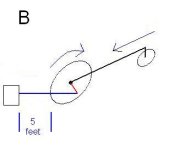tallyho8
Super Member
- Joined
- Aug 1, 2004
- Messages
- 5,256
- Tractor
- Kubota L4400, Kubota ZD326
Refer to the 2 images attached:
In image A the tractor is trying to go forward with the wheels spinning forward and is 6 feet from the immovable object.
In image B the tractors wheels are still spinning forward but the tractor is now only 5 feet from the immovable object where it would have to be if the chain were a consistent length and the front end was now lifted.
So your theory is that if the tractor produced enough torque going forward, the wheels would slip and go backward as the front end lifts?
In image A the tractor is trying to go forward with the wheels spinning forward and is 6 feet from the immovable object.
In image B the tractors wheels are still spinning forward but the tractor is now only 5 feet from the immovable object where it would have to be if the chain were a consistent length and the front end was now lifted.
So your theory is that if the tractor produced enough torque going forward, the wheels would slip and go backward as the front end lifts?


